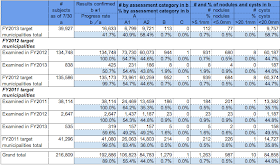On August 22, Mako Oshidori received an e-mail from the Public Relations Department of Radiation Medical Science Center for the Fukushima Health Management Survey at Fukushima Medical University, explaining the circumstances surrounding the discrepancies described in this post: http://fukushimavoice-eng2.blogspot.com/2013/08/unexplained-discrepancies-in-thyroid.html
*****
In regards to mistakes in the Proceedings of the Eleventh Fukushima Prefecture "Prefecture Health Management Survey" Oversight Committee.
Apologies for the delay, but we have confirmed how and why the above-mentioned mistakes were made. They are explained below.
We will be making an announcement to the prefecture and national residents at a later time, explaining the details.
We deeply regret and apologize for causing trouble for all involved by making mistakes in extremely important data.
《Corrections made》
① Results of cytological examination
① Results of cytological examination
Average age for FY2011 was changed from "17.3 ± 2.0 years" to "17.2 ± 1.9 years."
Age as of March 11, 2011 for FY2011 was changed from "age 11-17" to "age 11-18."
Average age for FY2012 was changed from 16.1 ± 2.6 years" to "16.1 ± 2.8 years."
② Corrections were made for the age and gender distribution graph for 28 cases confirmed or suspected of cancer.
《How mistakes were discovered》
After the handout material for the Twelfth Oversight Committee, held on August 20, 2013, was submitted to the prefectural government on August 5, 2013, Fukushima Medical University was contacted on August 12, 2013 by the prefectural government in regards to possible mistakes including some of the numbers.
First the Twelfth Oversight Committee report was reviewed, and the mistakes specified were revealed.
The committee made appropriate corrections.
Then the committee reviewed the proceedings of the Eleventh Oversight Committee meeting containing the same data. Similar mistakes were discovered and the corrected version was publicized after the August 20, 2013 meeting.
《Reasons why mistakes happened》
(1) Average age and age as of March 11, 2011, for FY2011
The individual who created the data calculated the ages from birth date of the subjects, but a calculation error was made for one subject in regards to "age at the time of secondary examination" and "age as of March 11, 2011."
(2) Average age for FY2012
A typographical error was made, showing the standard deviation as 2.6 instead of 2.8.
(3) Age and gender distribution graph
In creating the age and gender distribution graph for the 28 cases, "age as of March 11, 2011" was calculated by subtracting 2 years from "age at the time of secondary examination."
In addition, it was revealed that the age and gender did not match due to a sorting error of the individual processing data in making the graph.
"Age as of March 11, 2011" was corrected, and the sorting error was also corrected. This changed the number of subject as well as the number of male and female in each age group. The original data for the 28 cases is accurate and the gender ratio remains as is.
All of the errors originate in the fact that data processing was not scrutinized and detailed checks were not performed afterwards. We think the main reasons for the mistakes were because this was the material that was created for the first time for the Eleventh Oversight Committee meeting, and also because the data was handled by a limited number of individuals and did not go through multiple auditing processes.
《Future plans》
From now on, data processing personnel and all those involved will be reminded of the importance of carefully examining data. In addition, a system will be established in order to ascertain double checking when creating data.
As the Thyroid Examination Department encompasses multiple tasks, each person in charge of a specific task created the material (used in the report) and checked it himself/herself up to now. However, when creating the material to be submitted to the committee, we will check and confirm in an integrated manner by creating a team with clear job descriptions and expectation of responsibilities, and thus try to decrease careless mistakes.


























